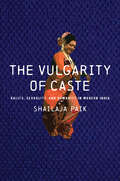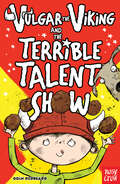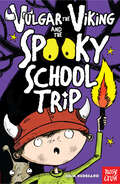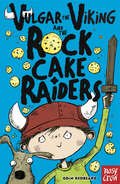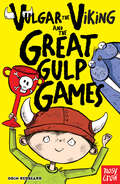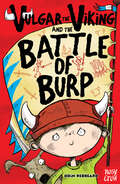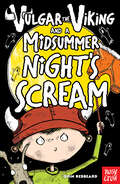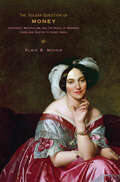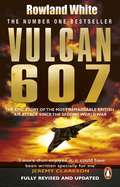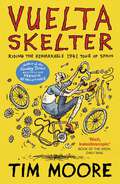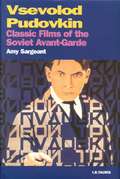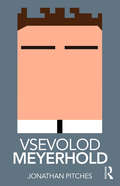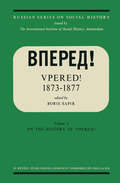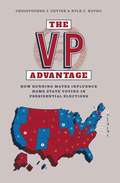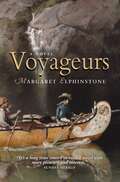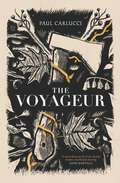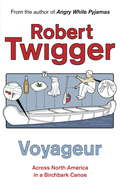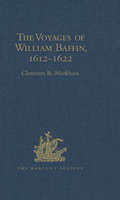- Table View
- List View
The Vulgarity of Caste: Dalits, Sexuality, and Humanity in Modern India (South Asia in Motion)
by Shailaja PaikThis book offers the first social and intellectual history of Dalit performance of Tamasha—a popular form of public, secular, traveling theater in Maharashtra—and places Dalit Tamasha women who represented the desire and disgust of the patriarchal society at the heart of modernization in twentieth century India. Drawing on ethnographies, films, and untapped archival materials, Shailaja Paik illuminates how Tamasha was produced and shaped through conflicts over caste, gender, sexuality, and culture. Dalit performers, activists, and leaders negotiated the violence and stigma in Tamasha as they struggled to claim manuski (human dignity) and transform themselves from ashlil (vulgar) to assli (authentic) and manus (human beings). Building on and departing from the Ambedkar-centered historiography and movement-focused approach of Dalit studies, Paik examines the ordinary and everydayness in Dalit lives. Ultimately, she demonstrates how the choices that communities make about culture speak to much larger questions about inclusion, inequality, and structures of violence of caste within Indian society, and opens up new approaches for the transformative potential of Dalit politics and the global history of gender, sexuality, and the human.
The Vulgarity of Caste: Dalits, Sexuality, and Humanity in Modern India (South Asia in Motion)
by Shailaja PaikThis book offers the first social and intellectual history of Dalit performance of Tamasha—a popular form of public, secular, traveling theater in Maharashtra—and places Dalit Tamasha women who represented the desire and disgust of the patriarchal society at the heart of modernization in twentieth century India. Drawing on ethnographies, films, and untapped archival materials, Shailaja Paik illuminates how Tamasha was produced and shaped through conflicts over caste, gender, sexuality, and culture. Dalit performers, activists, and leaders negotiated the violence and stigma in Tamasha as they struggled to claim manuski (human dignity) and transform themselves from ashlil (vulgar) to assli (authentic) and manus (human beings). Building on and departing from the Ambedkar-centered historiography and movement-focused approach of Dalit studies, Paik examines the ordinary and everydayness in Dalit lives. Ultimately, she demonstrates how the choices that communities make about culture speak to much larger questions about inclusion, inequality, and structures of violence of caste within Indian society, and opens up new approaches for the transformative potential of Dalit politics and the global history of gender, sexuality, and the human.
Vulgar the Viking and the Terrible Talent Show (Vulgar the Viking #4)
by Odin RedbeardViking based fiction, perfect for fans of How to Train Your Dragon!Related activity sheets available on the Nosy Crow website. "In this downright funny and entertaining series, Vulgar wants to be a real Viking however things don't always go according to plan for him... Full of humour, your children will devour these and they'll be begging you to read them the next one in the series!" - Theschoolrun.com From singing and dancing to doing things with pickled herring - the villagers of Blubber are gifted in many ways. And they've decided to have a talent contest to prove it. Vulgar knows it's his time to shine. Will he perform his armpit 'music' or juggle some elk poo? No! He will act out a Viking legend, with fighting and dragons and giants and all that stuff. And he will win! Won't he?
Vulgar the Viking and the Spooky School Trip (Vulgar the Viking #3)
by Odin RedbeardViking based fiction, perfect for fans of How to Train Your Dragon!Related activity sheets available on the Nosy Crow website. "In this downright funny and entertaining series, Vulgar wants to be a real Viking however things don't always go according to plan for him... Full of humour, your children will devour these and they'll be begging you to read them the next one in the series!" - Theschoolrun.comVulgar's new teacher is called Otto the Bone-Cruncher and he's a proper viking! Vulgar can't wait for the school trip, to learn all about hunting and exploring and having adventures. But after a very VERY long walk and a tea of roasted slugs, Vulgar's not so chipper. It's getting dark, and he's a bit spooked. There are trolls in these hills...
Vulgar the Viking and the Rock Cake Raiders (Vulgar the Viking #1)
by Odin RedbeardViking based fiction, perfect for fans of How to Train Your Dragon!Related activity sheets available on the Nosy Crow website. "In this downright funny and entertaining series, Vulgar wants to be a real Viking however things don't always go according to plan for him... Full of humour, your children will devour these and they'll be begging you to read them the next one in the series!" - Theschoolrun.comVulgar is a Viking boy who longs for the glory days of raiding, pillaging and enormous beards. Life in the village of Blubber is so dull, it's all knitting and goat-herding and yawwwnnn. Vulgar feels it's up to him to introduce a bit of mayhem and chaos, and just as soon as he's finished juggling with elk manure, he's going to relish the challenge.
Vulgar the Viking and the Great Gulp Games (Vulgar the Viking #2)
by Odin RedbeardViking based fiction, perfect for fans of How to Train Your Dragon!Related activity sheets available on the Nosy Crow website. "In this downright funny and entertaining series, Vulgar wants to be a real Viking however things don't always go according to plan for him... Full of humour, your children will devour these and they'll be begging you to read them the next one in the series!" - Theschoolrun.comEvery year, the village of Blubber competes against the neighbouring town of Gulp in the Viking Games, and every year, the Blubberers get thrashed. Convinced he can do better this time, Vulgar starts training - with comically catastrophic results - but worse is to come when he arrives at the Games to discover he and his friends have all been mistakenly entered into the goat hurdling! And when Vulgar's arch-enemy Gunnar turns up in the same event, the stage is set for the most ill-tempered and chaotic goat-hurdling race in Viking history.
Vulgar the Viking and the Battle of Burp (Vulgar the Viking #6)
by Odin RedbeardViking based fiction, perfect for fans of How to Train Your Dragon!Related activity sheets available on the Nosy Crow website. "In this downright funny and entertaining series, Vulgar wants to be a real Viking however things don't always go according to plan for him... Full of humour, your children will devour these and they'll be begging you to read them the next one in the series!" - Theschoolrun.comVulgar can't believe his luck. He's going on a school trip in a real, live longboat, with oars and everything! And they're going to visit Burp, where a long-ago battle once took place between the Vikings and the, er, Burpers. It was a mighty battle, which the Vikings totally lost. But this time, Vulgar's going to re-write history. He's up for a bit of historical re-enactment, and is sure, one way or another, that a great and noble victory will be his!
Vulgar the Viking and a Midsummer Night's Scream (Vulgar the Viking #5)
by Odin RedbeardViking based fiction, perfect for fans of How to Train Your Dragon!Related activity sheets available on the Nosy Crow website. "In this downright funny and entertaining series, Vulgar wants to be a real Viking however things don't always go according to plan for him... Full of humour, your children will devour these and they'll be begging you to read them the next one in the series!" - Theschoolrun.comVULGAR THINKS MIDSUMMER NIGHT'S EVE IS THE BEST VIKING FESTIVAL OF ALL! There'll be a massive bonfire, and everyone will sing songs about excellent longboats and enormous battles, then eat and drink until their stomachs explode! So what's with the tiny pile of firewood? And the maypole he's told to dance around? With Freya! NO WAY. Vulgar vows to make this Midsummer's Eve a night Blubber will remember for ever. It's going to be a SCREAM...
The Vulgar Question of Money: Heiresses, Materialism, and the Novel of Manners from Jane Austen to Henry James
by Elsie B. MichieIt is a familiar story line in nineteenth-century English novels: a hero must choose between money and love, between the wealthy, materialistic, status-conscious woman who could enhance his social position and the poorer, altruistic, independent-minded woman whom he loves. Elsie B. Michie explains what this common marriage plot reveals about changing reactions to money in British culture.It was in the novel that writers found space to articulate the anxieties surrounding money that developed along with the rise of capitalism in nineteenth-century England. Michie focuses in particular on the character of the wealthy heiress and how she, unlike her male counterpart, represents the tensions in British society between the desire for wealth and advancement and the fear that economic development would blur the traditional boundaries of social classes.Michie explores how novelists of the period captured with particular vividness England’s ambivalent emotional responses to its own financial successes and engaged questions identical to those raised by political economists and moral philosophers. Each chapter reads a novelist alongside a contemporary thinker, tracing the development of capitalism in Britain: Jane Austen and Adam Smith and the rise of commercial society, Frances Trollope and Thomas Robert Malthus and industrialism, Anthony Trollope and Walter Bagehot and the political influence of money, Margaret Oliphant and John Stuart Mill and professionalism and managerial capitalism, and Henry James and Georg Simmel and the shift of economic dominance from England to America.Even the great romantic novels of the nineteenth century cannot disentangle themselves from the vulgar question of money. Michie’s fresh reading of the marriage plot, and the choice between two women at its heart, shows it to be as much about politics and economics as it is about personal choice.
The Vulgar Question of Money: Heiresses, Materialism, and the Novel of Manners from Jane Austen to Henry James
by Elsie B. MichieIt is a familiar story line in nineteenth-century English novels: a hero must choose between money and love, between the wealthy, materialistic, status-conscious woman who could enhance his social position and the poorer, altruistic, independent-minded woman whom he loves. Elsie B. Michie explains what this common marriage plot reveals about changing reactions to money in British culture.It was in the novel that writers found space to articulate the anxieties surrounding money that developed along with the rise of capitalism in nineteenth-century England. Michie focuses in particular on the character of the wealthy heiress and how she, unlike her male counterpart, represents the tensions in British society between the desire for wealth and advancement and the fear that economic development would blur the traditional boundaries of social classes.Michie explores how novelists of the period captured with particular vividness England’s ambivalent emotional responses to its own financial successes and engaged questions identical to those raised by political economists and moral philosophers. Each chapter reads a novelist alongside a contemporary thinker, tracing the development of capitalism in Britain: Jane Austen and Adam Smith and the rise of commercial society, Frances Trollope and Thomas Robert Malthus and industrialism, Anthony Trollope and Walter Bagehot and the political influence of money, Margaret Oliphant and John Stuart Mill and professionalism and managerial capitalism, and Henry James and Georg Simmel and the shift of economic dominance from England to America.Even the great romantic novels of the nineteenth century cannot disentangle themselves from the vulgar question of money. Michie’s fresh reading of the marriage plot, and the choice between two women at its heart, shows it to be as much about politics and economics as it is about personal choice.
Vulcan - Long-range Medium Bomber (UEB uncontracted)
by RnibThis is an image of a jet bomber seen from above. There is a locator dot shown, which will be at the top left of the page when the image is the correct way up. The image is in the centre and a scale in metres on the left of the page. The aircraft nose is in the top centre and the tail in the bottom centre of the page. The fuselage goes up and down the middle of the page. The cockpit is shown as a tiny window near the nose. The wings sweep down to the left and right and are widest at the tail end. Sticking out from the end of the aircraft there are two jet engine nozzles to the left and right of the tail. The bottom edge of the wing has four flaps on each side, these are the ailerons used to manoeuvre the aircraft when it is flying.
Vulcan - Long-range Medium Bomber (UEB contracted)
by RnibThis is an image of a jet bomber seen from above. There is a locator dot shown, which will be at the top left of the page when the image is the correct way up. The image is in the centre and a scale in metres on the left of the page. The aircraft nose is in the top centre and the tail in the bottom centre of the page. The fuselage goes up and down the middle of the page. The cockpit is shown as a tiny window near the nose. The wings sweep down to the left and right and are widest at the tail end. Sticking out from the end of the aircraft there are two jet engine nozzles to the left and right of the tail. The bottom edge of the wing has four flaps on each side, these are the ailerons used to manoeuvre the aircraft when it is flying.
Vulcan - Long-range Medium Bomber (large print)
by RnibThis is an image of a jet bomber seen from above. There is a locator dot shown, which will be at the top left of the page when the image is the correct way up. The image is in the centre and a scale in metres on the left of the page. The aircraft nose is in the top centre and the tail in the bottom centre of the page. The fuselage goes up and down the middle of the page. The cockpit is shown as a tiny window near the nose. The wings sweep down to the left and right and are widest at the tail end. Sticking out from the end of the aircraft there are two jet engine nozzles to the left and right of the tail. The bottom edge of the wing has four flaps on each side, these are the ailerons used to manoeuvre the aircraft when it is flying.
Vulcan 607: The Epic Story Of The Most Remarkable British Air Attack Since The Second World War
by Rowland WhiteIt was to be one of the most ambitious operations since 617 Squadron bounced their revolutionary bombs into the dams of the Ruhr Valley in 1943 . . . April 1982. Argentine forces had invaded the Falkland Islands. Britain needed an answer. And fast. The idea was simple: to destroy the vital landing strip at Port Stanley. The reality was more complicated. The only aircraft that could possibly do the job was three months from being scrapped, and the distance it had to travel was four thousand miles beyond its maximum range. It would take fifteen Victor tankers and seventeen separate in-flight refuellings to get one Avro Vulcan B2 over the target, and give its crew any chance of coming back alive.Yet less than a month later, a formation of elderly British jets launched from a remote island airbase to carry out the longest-range air attack in history. At its head was a single aircraft, six men, and twenty-one thousand-pound bombs, facing the hornet’s nest of modern weaponry defending the Argentine forces on the Falkland Islands. There would be no second chances . . .
Vuelta Skelter: Riding the Remarkable 1941 Tour of Spain
by Tim MooreTim Moore completes his epic (and ill-advised) trilogy of cycling's Grand Tours.Julian Berrendero's victory in the 1941 Vuelta a Espana was an extraordinary exercise in sporting redemption: the Spanish cyclist had just spent 18 months in Franco's concentration camps, punishment for expressing Republican sympathies during the civil war. Seventy nine years later, perennially over-ambitious cyclo-adventurer Tim Moore developed a fascination with Berrendero's story, and having borrowed an old road bike with the great man's name plastered all over it, set off to retrace the 4,409km route of his 1941 triumph - in the midst of a global pandemic.What follows is a tale of brutal heat and lonely roads, of glory, humiliation, and then a bit more humiliation. Along the way Tim recounts the civil war's still-vivid tragedies, and finds the gregarious but impressively responsible locals torn between welcoming their nation's only foreign visitor, and bundling him and his filthy bike into a vat of antiviral gel.
Vsevolod Pudovkin: Classic Films of the Soviet Avant-garde (KINO - The Russian and Soviet Cinema)
by Amy SargeantPudovkin is listed amongst the great and the good of twentieth century directors: his influence is acknowledged by such diverse figures as Hitchcock and Kubrick, Zavattini and Mamet, and Walter Benjamin usedhis work as a vital source forhis studies of the aesthetics and cultural politics of the period.Vsevelod Pudovkin: Classic Works of the Soviet Avant-Garde is the first book on Pudovkin for more than twenty-five years. It covers his career from his apprenticeship with Gardin and Kuleshov in the early '20s to his sound films of the early '30s. It discusses films on which Pudovkin worked as director, as collaborator and in which he appeared, from the famous troika, The Mother, The End of St Petersburg and Storm over Asia to the lesser known The Mechanics of the Brain and The Living Corpse. Pudovkin's art is placed in the context of his contribution to the cultural and political fervour of Soviet Russia after the Revolution, and especially the theoretical disputes with his contemporary Eisenstein. The book also suggests broader alignments within European avant-garde movements and takes a close look at the influence D. W. Griffith exerted over this giant of early Soviet film-making.Vsevelod Pudovkin: Classic Films of the Soviet Avant-Garde is the companion volume to Richard Taylor's translations of Pudovkin's writings, The Pudovkin Collection.
Vsevolod Meyerhold (Routledge Performance Practitioners)
by Prof Jonathan PitchesVsevolod Meyerhold considers the life and work of the extraordinary twentieth-century director and theatre-maker. This compact, well-illustrated volume includes: a biographical introduction to Meyerhold’s life a clear explanation of his theoretical writings an analysis of his masterpiece production Revisor, or The Government Inspector a comprehensive and usable description of the ‘biomechanical’ exercises he developed for training the actor. As a first step towards critical understanding, and as an initial exploration before going on to further, primary research, Routledge Performance Practitioners offer unbeatable value for today's student.
Vsevolod Meyerhold (Routledge Performance Practitioners)
by Prof Jonathan PitchesVsevolod Meyerhold considers the life and work of the extraordinary twentieth-century director and theatre-maker. This compact, well-illustrated volume includes: a biographical introduction to Meyerhold’s life a clear explanation of his theoretical writings an analysis of his masterpiece production Revisor, or The Government Inspector a comprehensive and usable description of the ‘biomechanical’ exercises he developed for training the actor. As a first step towards critical understanding, and as an initial exploration before going on to further, primary research, Routledge Performance Practitioners offer unbeatable value for today's student.
“Vpered!” 1873–1877: From the Archives of Valerian Nikolaevich Smirnov (Russian Series On Social History Ser. #1)
by Brian Pearce Boris SapirThe publication of the following material on the history of Vpered represents the fulfilment of a duty both to the founders of the International Institute of Social History and to Nadezhda Nikolaevna Kolachevskaia and Valerian Valerianovich Kolachevskii, who handed over to the Institute so long ago as 1936 the papers of their late husband and father, Valerian a Nikolaevich Smirnov. ) The Institute undertook at that time to publish these papers, and V. V. Kolachevskii planned to use them in compiling a biography of his father. The Second World War and its consequences imposed changes in these plans. The biography of V. N. Smirnov remained unwritten, and work on the publication of documents from his papers was interrupted for a quarter of a century. First, however, some particulars of these papers. We are here concerned with that section of them which relates to a remarkable literary organ of the Russian revolutionary Populist move ment, the occasional symposia and the fortnightly newspaper, both called Vpered, founded by Petr Lavrovich Lavrov in 1873. Lavrov was the sole editor of the four volumes of occasional symposia (the fourth volume contains only one issue) which were published in Zurich and London between 1873 and 1876, and the 48 issues of the fortnightly newspaper published in London in 1875 and 1876.
The VP Advantage: How running mates influence home state voting in presidential elections (PDF)
by Christopher Devine Kyle C. KopkoA widespread perception exists among political commentators, campaign operatives and presidential candidates that vice presidential (VP) running mates can deliver their home state's electoral votes in a presidential election. In recent elections, presidential campaigns have even changed their strategy in response to the perceived VP home state advantage. But is the advantage real? And could it decide a presidential election? In the most comprehensive analysis to date, Devine and Kopko demonstrate that the VP home state advantage is actually highly conditional and rarely decisive in the Electoral College. However, it could change the outcome of a presidential election under narrow but plausible conditions. Sophisticated in its methodology and rich in historical as well as contemporary insight, The VP Advantage is essential and accessible reading for anyone interested in understanding how running mates influence presidential elections.
The VP Advantage: How running mates influence home state voting in presidential elections
by Christopher Devine Kyle C. KopkoA widespread perception exists among political commentators, campaign operatives and presidential candidates that vice presidential (VP) running mates can deliver their home state's electoral votes in a presidential election. In recent elections, presidential campaigns have even changed their strategy in response to the perceived VP home state advantage. But is the advantage real? And could it decide a presidential election? In the most comprehensive analysis to date, Devine and Kopko demonstrate that the VP home state advantage is actually highly conditional and rarely decisive in the Electoral College. However, it could change the outcome of a presidential election under narrow but plausible conditions. Sophisticated in its methodology and rich in historical as well as contemporary insight, The VP Advantage is essential and accessible reading for anyone interested in understanding how running mates influence presidential elections.
Voyageurs: A Novel
by Margaret ElphinstoneIn the early 1800s, Rachel Greenhow, a young Quaker, goes missing in the Canadian wilderness. Unable to accept the disappearance, her brother Mark leaves his farm in England, determined to bring his sister home. What follows is a gripping account of Mark's odyssey and his travels with the voyageurs - the men who canoe Canada's fur-trade route. As adventure and discovery propel the plot forward, Elphinstone takes the reader back in time and intertwines the story with enduring themes of love, war and family ties.
The Voyageur: 'Marvellous work of art' John Banville
by Paul Carlucci'Exceptionally vivid and intense' Sunday Times But everyone expects at least a little bit of deception as they go through their days and nights, and there's a chance of winning nevertheless, so many choose to play Alex is a motherless stockboy in 1830s Montreal, waiting desperately for his father to return from France. Serge, a drunken fur trader, promises food and safety in return for friendship, but an expedition into the forest quickly goes awry. At the mercy of men whose motives are unclear, Alex must learn to find his own way in a world where taking advantage of others has become second nature. But will he have to abandon his humanity to survive? The Voyageur is a brilliantly realised novel set on the margins of British North America, where kindness is costly, and where the real wilderness may not be in the landscape surrounding Alex but in the deceptive hearts of men.
Voyageur: Across The Rocky Mountains In A Birchbark Canoe
by Robert TwiggerBest-selling author of Angry White Pyjamas travels across the Rocky Mountains by canoe Fifteen years before Lewis and Clark, Scotsman Alexander Mackenzie, looking to open up a trade route, set out from Lake Athabasca in central Northern Canada in search of the Pacific Ocean. Mackenzie travelled by bark canoe and had a cache of rum and a crew of Canadian voyageurs, hard-living backwoodsmen, for company. Two centuries later, Robert Twigger decides to follow in Mackenzie's wake. He too travels the traditional way, having painstakingly built a canoe from birchbark sewn together with pine roots, and assembled a crew made up of fellow travelers, ex-tree-planters and a former sailor from the US Navy. Several had tried before them but they were the first people to successfully complete Mackenzie's diabolical route over the Rockies in a birchbark canoe since 1793. Their journey takes them to the remotest parts of the wilderness, through Native American reservations, over mountains, through rapids and across lakes, meeting descendants of Mackenzie and unhinged Canadian trappers, running out of food, getting lost and miraculously found again, disfigured for life (the ex-sailor loses his thumb), bears brown and black, docile and grizzly.
The Voyages of William Baffin, 1612-1622 (Hakluyt Society, First Series)
by Clements R. MarkhamEdited, with notes and an introduction from narratives and journals by John Gatonbe, Robert Fotherby, and others, with Baffin's letters, journals, and other observations, and various treatises on the probability of a North-West Passage. This is a new print-on-demand hardback edition of the volume first published in 1881. Owing to technical constraints it has not been possible to reproduce 'The Map of Coast of Arabia and entrance to the Pendant Gulf' which appeared on p.xliii of the first edition of this volume.
